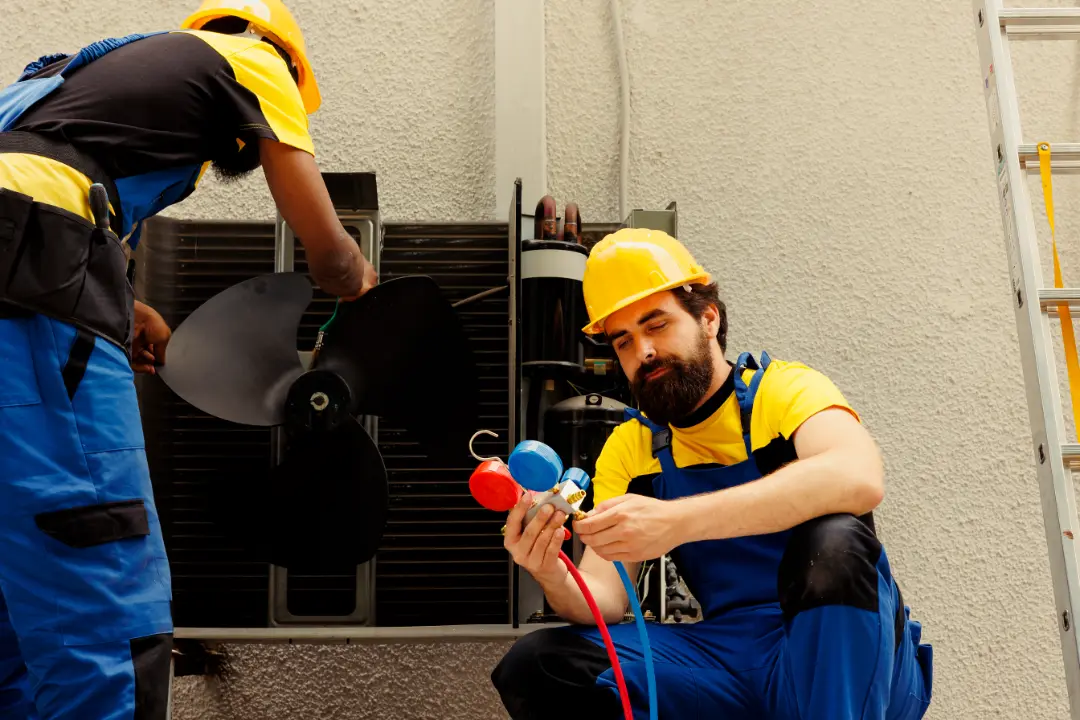Ever wondered how an air conditioner works? In simple terms, it absorbs heat from a room and releases it outside, thanks to a crucial component—refrigerant. This guide will break down how the essential parts of an air conditioner, such as the evaporator coil and compressor, work together to keep your space cool. By the end, you’ll clearly understand how this everyday appliance keeps you comfortable.
Key Takeaways
- Air conditioners utilise the principle of heat transfer and the refrigerant’s ability to change from liquid to gas to absorb indoor heat and release it outdoors, providing a consistent cooling effect.
- The key components of an air conditioner include an indoor unit with an evaporator coil and fan and an outdoor unit with a compressor and condenser coil, which work together to complete the cooling cycle.
- Smartway Air Conditioning specialises in installing, repairing and maintaining various types of air conditioning systems in Sydney, offering tailored solutions and professional services for optimal system performance and durability.
What Does an Air Conditioner Do?
An air conditioner is an impressive system designed to regulate temperature, humidity, and air quality in your home or office. At its core, an air conditioner operates by transferring heat from one location to another, creating a comfortable indoor environment. This process relies on a refrigerant—a special fluid that changes from liquid to gas and back, enabling efficient heat transfer.
An air conditioner works in stages: compression, condensation, expansion, evaporation, and heat transfer. The refrigerant absorbs heat from the indoor air, evaporating into a gas. It’s then compressed and moved to the outdoor unit, where it releases this heat and returns to liquid form, completing the cooling cycle.
Additionally, many air conditioners can provide heating during cold seasons, making them versatile year-round appliances.
How Does an Air Conditioning System Work?
Air conditioning systems are essential in providing relief from hot and stuffy air. But how exactly do they work? The principle of heat transfer is central to their operation. These systems smartly move heat from the indoors to the outdoors, creating a cool and refreshing atmosphere as air flows over the evaporator and condenser coils. The refrigerant plays a crucial role in this process as it absorbs and expels heat effectively.
The Function of Refrigerant Gas
Refrigerants such as R-32 and R-410A play a crucial role in air conditioning by their ability to effortlessly switch between liquid and gas states, making them perfect for heat transfer.
As the cold refrigerant absorbs heat from the indoor air, it transforms from a liquid state to a gaseous state, effectively removing the unwanted warmth.
This phase change from liquid to gas is essential to the cooling process, converting our rooms and offices into comfortable spaces even in the peak of summer and providing the comfort that air conditioners are designed for.
The Cycle of Cooled Air
Cooled air begins its journey at the evaporator coil, where the refrigerant absorbs heat from the warm air, cooling and dehumidifying it. After the evaporator coil completes its function, the refrigerant cycles back to the compressor, where the process repeats.
A valve regulates this cycle, ensuring that your indoor air stays at a comfortable temperature and provides consistent cooling.
The Parts of an Air Conditioning Unit
An air conditioning unit comprises several essential components, including the evaporator, compressor, condenser, and expansion valve.
A standard air conditioner comprises three main mechanical parts: the compressor, condenser, and evaporator.
The compressor increases the temperature of the refrigerant to prepare it for condensing, while the condenser helps to lower the temperature of the refrigerant by releasing heat to the outside air. Each component plays a vital role in the cooling process.
Indoor Unit Components
The indoor unit is crucial for cooling the air. It contains the evaporator coil, which absorbs heat and turns refrigerant from liquid to gas. A fan pulls warm air over the evaporator coil, cooling it before releasing it back into the room.
This unit also includes a drainpipe and cooling fan, which regulate humidity and manage heat absorption, ensuring a comfortable environment.
Outdoor Unit Components
The outdoor unit plays a key role in heat exchange. It houses the compressor, which compresses refrigerant gas, sending it to the condenser coil. The condenser releases the heat outdoors, allowing the refrigerant to return to a liquid state. The expansion valve then lowers the pressure, starting the cooling process again. Together, these components work to efficiently cool your indoor space.
Split System Air Conditioners
Split-system air conditioners are popular with homeowners and businesses because of their functionality. These systems consist of two components: an indoor unit and an outdoor unit that are connected by refrigerant pipework and electrical cables.
One significant benefit of split-system air conditioners is their versatility. There are also multi-split systems, which feature multiple indoor units connected to a single outdoor unit. This feature allows for efficient individual cooling of separate rooms or zones, which is impossible with single-split systems designed to cool only one room.
The Cooling Cycle: From Warm Indoor Air to Cool Comfort
The process of the cooling cycle is fascinating as it transforms warm indoor air into a comfortable cool. Firstly, the warm indoor air flows through a cold cooling coil that contains refrigerant. This exchange allows the air to be cooled, and then it is circulated back into the room. The air loses its heat to the refrigerant, which cools it down, providing a refreshing respite from the heat.
The cooled air is then circulated back into the room, reducing the indoor temperature. This process continues cyclically, ensuring that the indoor environment remains comfortably cool, even on the hottest days.
Choosing the Right Air Conditioner for Your Space
Selecting the perfect air conditioner for your space involves considering several key factors, including the size of the room, the local climate, and your budget. With various types of air conditioners available, such as window units, split systems, and ductless systems, it’s essential to choose one that best fits your needs.
- Room Size: Ensure the air conditioner you choose is appropriately sized for your room. An undersized unit will struggle to cool the space, while an oversized unit may cool too quickly without properly dehumidifying the air.
- Climate: In hot and humid climates, opt for an air conditioner with a high cooling capacity to effectively manage the heat and humidity.
- Budget: Air conditioners come in a wide price range. Set a budget that balances cost with the features and efficiency you need.
- Energy Efficiency: Look for air conditioners with high energy efficiency ratings, such as Energy Star-certified models, to save on energy bills.
- Features: Consider additional features like air purification, dehumidification, and smart sensors that can enhance comfort and convenience.
Window units are ideal for small rooms and are easy to install, while split systems offer greater efficiency and can cool larger spaces. Ductless systems are perfect for homes without existing ductwork and can be more energy-efficient. By carefully evaluating these factors, you can choose an air conditioner that provides optimal comfort and efficiency for your space.
Energy Efficiency and Air Conditioners
Air conditioners can be significant energy consumers, but there are several strategies to enhance their energy efficiency and reduce your energy bills. Here are some practical tips:
- Programmable Thermostat: Use a programmable thermostat to regulate the temperature and reduce energy consumption when you’re not home. This ensures your air conditioner runs only when needed.
- Regular Maintenance: Clean or replace the air filter regularly to improve airflow and reduce energy consumption. A clean filter ensures your air conditioner works efficiently.
- Ceiling Fans: Ceiling fans circulate air, which can help reduce the need for air conditioning. They also create a wind-chill effect, making the room feel cooler.
- Energy-Efficient Models: Choose air conditioners with high energy efficiency ratings, such as Energy Star-certified models. These units use less energy to provide the same level of cooling. Additionally, look for air conditioners with features like inverter technology, which can improve energy efficiency and reduce noise levels.
- Upgrades: Consider upgrading to a more energy-efficient air conditioner, such as a ductless system or a heat pump. These systems often offer better performance and lower energy consumption.
By following these tips, you can enjoy a comfortable indoor environment while keeping your energy consumption in check.
Choose Smartway Air Conditioning For Expert AC Installations, Maintenance and Repairs in Sydney
SmartWay Air Conditioning is the right choice for expert AC installations, maintenance, and repairs in Sydney. We offer high-performance air conditioning units customised to suit your Sydney home’s specific needs. Our services are reliable and accessible to everyone in Sydney.
We provide professional air conditioning installation services tailored to your specific requirements. This ensures that each system is customised for optimal performance, providing efficient cooling that is tailored to your needs and preferences. Our team consists of certified HVAC professionals, each an expert in the field, ensuring high-quality installation services.
At SmartWay, we offer versatile solutions for residential and commercial properties. We handle a range of air conditioning systems, including split system air conditioners, ducted air conditioners, and multi-split air conditioners, to suit different environments. With SmartWay, everyone can enjoy the comfort of a well-cooled space. Request a free quote today.
Enhance Your Air Conditioning Experience With Adequate Maintenance
Efficient air conditioning system maintenance can enhance its operation and overall cooling experience. One of the simplest ways to achieve this is by regularly cleaning or replacing dirty or old air conditioner filters, which can reduce your system’s energy consumption by 5% to 15%.
It’s also important to keep the area around the outdoor condenser unit clean and debris-free to ensure adequate airflow around the condenser. Clearing the condensate drains and inspecting the seal between a room air conditioner and the window frame at the beginning of the cooling season can prevent cool air from escaping.
During winter, protecting your units from harsh weather can prolong their lifespan.
Frequently Asked Questions
What’s the difference between a single-split and multi-split air conditioning system?
The main difference is that a single-split system cools one room. In contrast, a multi-split system can cool multiple rooms separately by connecting multiple indoor units to one outdoor unit. So, it depends on whether you need to cool multiple rooms or just one.
How can I enhance my air conditioning experience?
To enhance your air conditioning experience, regularly maintain your unit by cleaning or replacing filters, keeping the outdoor condenser unit area clean, and clearing condensate drains to ensure optimal performance and efficiency.
How does the air conditioning process work to cool my home?
The air conditioning process works by air blowing past a series of coils filled with refrigerant, which absorbs the heat from the air inside your home. The hot air is then expelled outside, while cooler, conditioned air is circulated back indoors. This continuous cycle helps keep your home cool by removing heat from the indoor air and releasing it into the outdoor air. It’s important to note that air conditioners do not create cold air; they remove heat from the indoor air, resulting in cooler air being circulated indoors.
Conclusion
Air conditioning systems are essential for maintaining a comfortable and cool indoor environment, and understanding how they work can deepen your appreciation for their efficiency. From the intricate heat exchange process to the crucial role of refrigerants, air conditioners are marvels of modern technology.
At SmartWay Air Conditioning, we are committed to providing high-quality, tailored installations, reliable repairs, and ongoing maintenance to ensure your system operates at peak performance. Trust our team of experts to enhance your comfort and keep your air conditioning running smoothly. Contact us today for a fast and free quote, and let us help you enjoy optimal cooling all year round.


